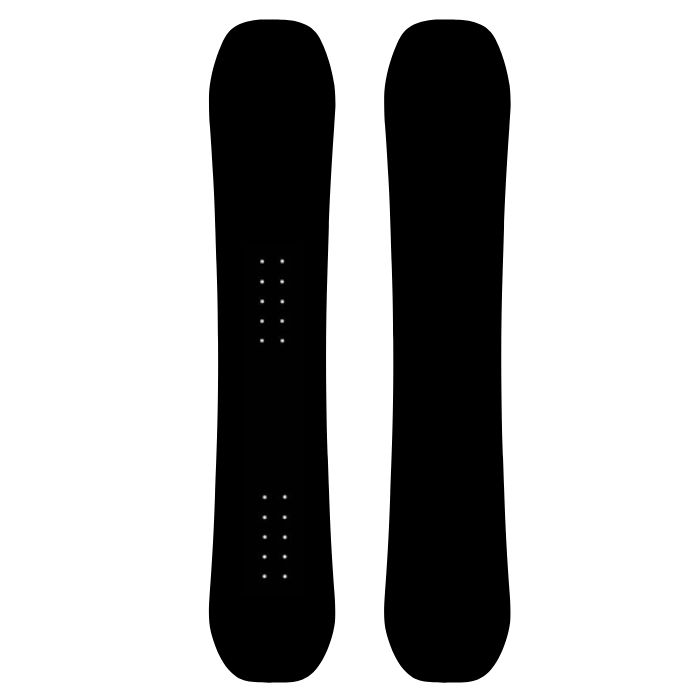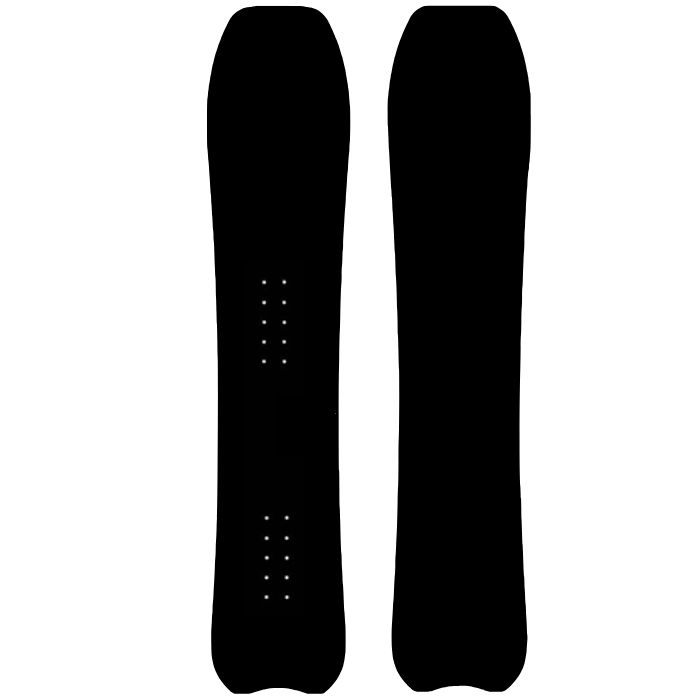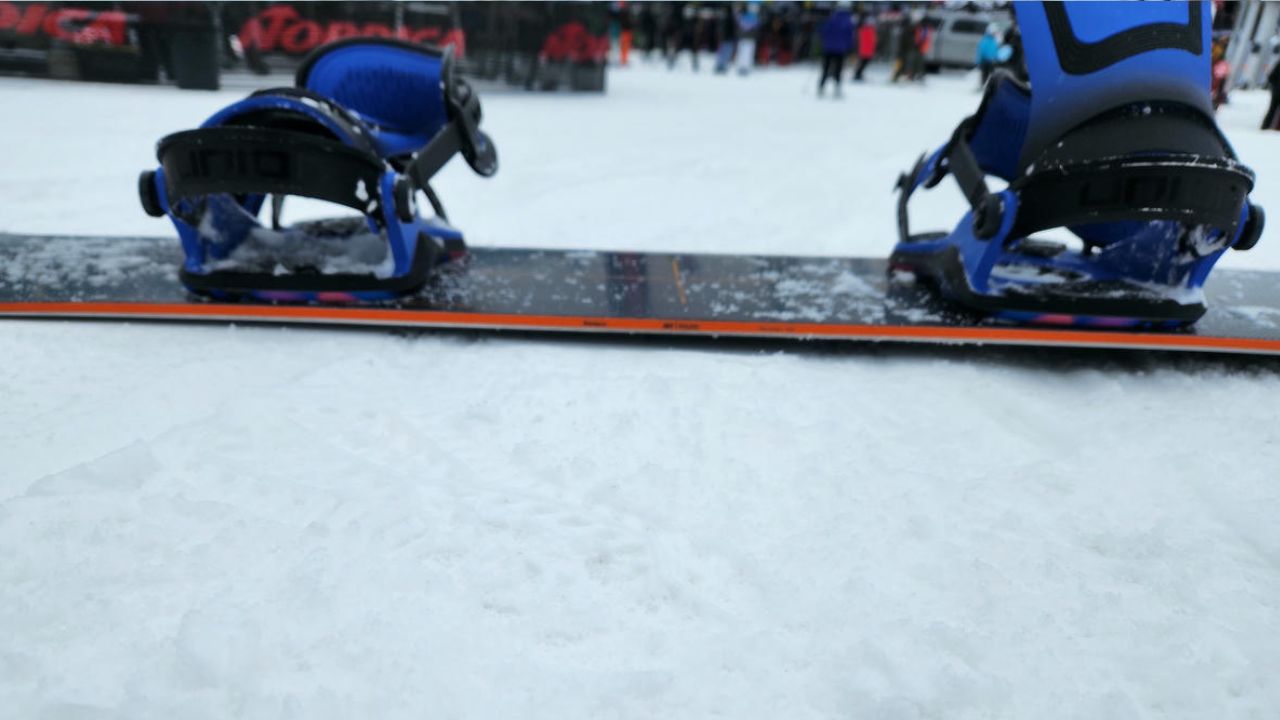What Type of Riding Do You Do Most Often?
Simple Guide to the Three Main Snowboard Shapes
Twin Snowboard Shape

- Shape: Perfectly symmetrical nose and tail.
- Stance in relation to nose and tail: Centered or no setback distance
- Floatation Level for Powder: Lowest. The twin shape is mainly for designed for maneuverability, not for floating in powder.
- Best for: All mountain riding, park riding, freestyle, jibbing, jumping and switch riding.
- Skill Level: Any rider can enjoy a twin. This shape is the easiest to learn on, so we recommend beginners start with this.
Directional Twin Snowboard Shape

- Shape: Slightly longer or wider nose than tail.
- Stance in relation to nose and tail: This can vary from slightly set back from center (by a few centimeters) or dramatically. The main idea is that standing further back towards the tail improves the boards turning experience for your dominant stance and improves the boards versatility by improving its float in powder.
- Float: Varies depending on set back distance and shape of the board. Generally, the longer the nose, the better it will float.
- Best for: All-mountain riding with some powder capability. A good blend of freestyle freedom and directional performance.
- Skill Level: Any rider can enjoy a directional twin.
Directional Snowboard Shape

- Shape: Characterized by a dramatically different looking nose than tail. Often, there will be a noticeably longer and wider nose when compared to the tail. The board may also have taper (where the tail is narrower than the waist).
- Stance in relation to nose and tail: Set back from center (often a couple of inches or more). The set back stance tends to be significant as it helps keep the nose up in powder and aids in control at speed.
- Float: Highest. Designed to plane on top of deep snow.
- Best for: Powder riding, freeriding, and stability at high speeds.
- Skill Level: Generally recommended for intermediate level riders and up due to the varied shape of the board.
Cheat Sheet for the Different Curvature Profiles of Your Snowboard
The camber profile, also known as the snowboard profile or rocker profile, refers to the curvature of the board when it rests flat on the snow.
Your board’s profile dramatically influences how it performs while you ride. The snowboard’s profile determines whether the board feels playful and easy to ride or powerful and stable. Depending on how you like to ride, there is a camber profile for you.
This cheat sheet covers each type of snowboard profile and provides a quick summary of when it is beneficial to choose that profile type. While countless hybrid profiles emerge each season, they all originate from one of six fundamental snowboard profiles, which I’ll summarize below.
So let’s dive in to each profile.
Camber Snowboard Profile

A snowboard with a camber profile has a lowercase “n” shaped arc between the bindings. Camber is the most traditional snowboard profile. Whenever the arc of the camber profile is bent, it always wants to quickly snap back into its original shape. The result of that reaction offers the snowboard an additional level of pop, superior edge hold, and a lively feel as the board rolls from edge to edge between turns. Most intermediate to advanced-level riders prefer a camber snowboard profile.
Rocker / Reverse Camber Snowboard Profile

A snowboard with a rocker, or reverse camber, profile has a lowercase “u” shaped arc between the bindings. Reverse camber is the second most popular board profile and tends to be a beginner-friendly type of snowboard. The reverse camber profile feels looser, or more forgiving, on the snow because the contact points of the snowboard are pointing upward and off of the snow. With a rocker profile, riders who are just beginning won’t accidentally get their edge caught in the snow as they are learning the fundamentals. Additionally, reverse camber snowboard profiles can make certain tricks like butters or nose presses very simple because the snowboard’s nose and tail are already curved upward.
Flat Snowboard Profile

A snowboard with a flat camber profile has no curvature between the bindings. This snowboard is completely flat when it is riding on snow. The primary benefit of a flat snowboard is that there is more surface area in contact with the snow, so this type of snowboard offers additional stability for beginner riders. The downside is that an experienced rider will find this type of camber profile feels slow to ride.
Hybrid Camber Snowboard Profile

A hybrid camber snowboard combines the best of both worlds by incorporating a primary positive camber between the bindings in the shape of a lowercase “n” arc and reverse camber curves resembling a lowercase “u” in the nose and tail. This unique profile offers the advantages of both camber and reverse camber. With a hybrid camber snowboard, riders experience the power and pop of a camber snowboard while enjoying the forgiving, surfy feel of a rocker snowboard. This camber profile caters to riders who enjoy the benefits of a traditional camber snowboard while also looking for a board with the catch-free, easy-to-ride feel of a reverse camber board.
Hybrid Rocker Snowboard Profile

A hybrid rocker snowboard profile offers the advantages of a rocker-dominant snowboard with the power of a traditional camber profile. The hybrid rocker profile has a primary reverse camber, lowercase “u” shaped arc between the bindings, while the nose and tail both have a camber profile lowercase “n” arc underfoot. This hybrid profile offers the best of both types of camber, providing riders with the forgiving, easy-to-ride feel of having reverse camber between their feet while delivering the explosive power and pop with positive camber in both the nose and tail. This snowboard profile is ideal for riders who enjoy reverse camber and are looking for a snowboard with the benefits of traditional camber.
Setback Camber Snowboard Profile

A setback camber profile is found in directional freeride and powder snowboards. This profile has the traditional camber lowercase “n” shaped arc between the rider’s bindings. Due to directional snowboards already having a setback stance, the camber profile is set back on the board to match where the rider stands. The nose of the snowboard has a reverse camber lowercase “u” shaped arc. The benefit of this profile is that the reverse camber in the nose keeps the nose pointing upward to help the board float in deeper snow, while the camber profile between the feet offers the power, pop, and turn initiation of a traditional camber profile.
What Are the Differences Between Camber and Rocker Snowboard Profiles?
While any beginner snowboarder can learn on either a camber or a rocker profile, each profile type offers a few advantages over the other. For example, a rocker profile has its nose and tail lifted off the snow, making the board feel more forgiving and less catchy. This makes it easier for beginners to avoid accidentally catching their edges as they learn to carve. Additionally, this profile type makes the board feel more playful and skate-like, so it’s a fun type for experienced riders who are looking to jib or butter.
Camber profiles, on the other hand, tend to be better for experienced riders looking for strong edge hold (grip while carving) and pop (that springboard-like feeling that boosts jumps and ollies). This is because the board’s upward bend between your feet stores energy, and when the board rebounds back to its natural shape, it releases power to snap against the snow. This makes for a more powerful turning experience and more airtime off jumps.
Here’s a quick summary between Camber and Rocker profiles:
Camber:
- Pros: Exceptional edge hold for carving and control on ice, more pop for jumps and ollies, powerful and responsive feel.
- Cons: Less forgiving, easier to catch an edge at low speeds, can be challenging for beginners.
Rocker:
- Pros: More forgiving, reduces edge catches, easier to learn on, playful and loose feel.
- Cons: Weaker edge hold, less stable at high speeds or on ice, less pop for jumps.
Ultimately, the best profile and shape come down to your personal riding style and preferences. Use our tool as a starting point, but don’t be afraid to experiment. Trying different boards is the absolute best way to learn what truly feels right under your feet.
Good luck with your board search!
Steve Weber is the passionate snowboarder, skateboarder, and author behind Board of the World. He understands that most gear reviews focus on having the perfect snow conditions, but his testing methodology is different. Living in Pennsylvania, Steve describes exactly how a board performs when the conditions aren’t perfect. His reviews cover performance on ice, hardpack, and flat-out brick conditions. In other words, he reviews boards for the conditions that East Coast riders actually face.
Bringing 27 years of East Coast snowboarding and 21 years of skateboarding experience, Steve is a 42-year-old intermediate park rider. His recommendations are informed by decades of battling icy conditions, ensuring every review accounts for the board’s performance on the roughest of terrain.
For the last five years, Steve has poured his passion into writing in-depth, unbiased reviews that help riders make informed decisions about the gear they’ll use. He also works part-time at a snowboard shop in Northeastern Pennsylvania, which gives him a direct line to learning about the new gear tech months in advance. When he’s not writing reviews, Steve is often found riding at Montage Mountain and testing out new boards.
Steve’s goal with Board of the World is simple: to help every reader find the right gear so they can have fun outside from the first time they use it.

